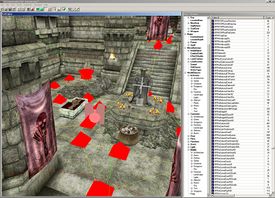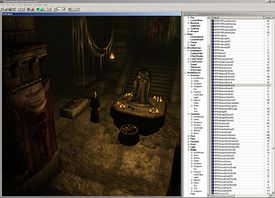General:Michael Ryan: The Darker Side of Cyrodiil
This is a developer diary for The Elder Scrolls IV: Oblivion. The original diary can be found here.
Michael Ryan - Level Designer
Surface dwellers. They just never quit with the "Cyrodiil is sooo beautiful" talk. You'd think Cyrodiil was a perfectly lush world full of dense forests, majestic mountain ranges, and teeming cities the way these sun-loving freaks go on and on about the place. Me? I prefer the warm glow of torch light and the quaint, quiet beauty of a cozy dungeon. Why venture above ground at all when a good dungeon offers dark corridors to explore, dastardly traps to avoid, and creatures of unspeakable evil to fight? Even if you are a misguided fan of natural lighting, I think you'll come around to my way of thinking after a healthy, Oblivion dungeon romp.
When I joined Bethesda I became the sixth member of a growing dungeon team - the portion of the Oblivion dev team that basically does nothing but design, build, test, and tweak dungeons. We've since added two more dungeoneers to our ranks and as a group, we have now hand-crafted more than 200 subterranean locales to explore and pillage while playing Oblivion.
Our team's mandate, all along, has been to inject more fun and more atmosphere into the dungeon experience. We wanted to avoid creating a large collection of beautiful spaces filled with nothing to do. At the same time, we wanted to make sure that the dungeons were unique and memorable - not just a series of cookie-cutter holes in the ground with some loot and a few skeletons. Amazingly, we're now at the point where we are wrapping up work on the dungeons and putting the finishing touches on most of them. Honestly, there were times I thought we'd never make it this far. Some days, the dungeon list looked a little like an ever-stretching hallway straight out of a Hitchcock film.
Because the game has so many dungeons, we tackled the job in stages, chipping away at the lengthy list and adding more and more polish over time. Each builder on the team has a preferred process for designing a solid dungeon, but we all start with the basic layout of the environment. Oblivion has a very powerful (and cool-looking) map feature that can help you find your way through the toughest of labyrinths, but that's still no substitute for a coherent, well-planned layout. Not only will the layout dictate the pacing of your combat encounters in the dungeon, but it will also determine the available lighting options at your disposal (which in turn, have a huge impact on how well the dungeon will actually run). As often as possible, we also try to incorporate elements such as multiple paths, dramatic overlook spots, and cool vista moments. Throughout the process, the dungeon type (marauder fortress, goblin cave, vampire lair, etc.) determines the architecture we use and the types of spaces the layout can and should use.
Lighting is the next big hurdle -- and by far, the most time consuming part of the process (at least for me). Getting the lighting right is a tricky job and even in these late stages, the lighting of the dungeons is still an ongoing process. It's been a tough task to balance aesthetics with performance, as the lighting obviously affects both of these elements in a big way. Fewer lights mean a better frame rate, but will also lead to a dungeon so dark that no one will be able to navigate through it. We purposely made the dungeons much darker than those in Morrowind, since we really wanted them to feel like dark, foreboding places burrowed deep beneath Cyrodiil and not just a series of brightly-lit rooms that happen to be full of loot and monsters. However, you are simply not going to have fun in a dungeon if it's too dark to find your way. So we are constantly adjusting the lights based on our own testing, as well as on the feedback we get from the rest of the team.
Once a layout is created and a basic lighting pass is in place, we populate the dungeon with monsters and/or hostile NPCs. Almost all of the dungeon encounters in Oblivion are leveled to the player, which means that as you progress through the game you will encounter tougher and more varied enemies. Note that this doesn't mean that all encounters are your level - not by a long shot. It just means that your level determines what types of creatures and NPCs you're likely to meet in the deepest, darkest places of Cyrodiil. Sometimes you'll run into low-level critters that you can dispatch with a single fireball; other times you won't be so lucky.
You'll also encounter a variety of traps and other obstacles that - like everything else - are tied to the theme of the dungeon. So while bandits will protect their hideouts with hastily assembled log traps and trip wires, the undead lurking in an ancient tomb might have more magical - but equally as deadly - defenses in place. Many of our traps are physics based, which has led to some seriously devious fun during the level design process. Again, when it comes to traps and to monster placement we rely heavily on feedback from the rest of the team to keep us honest. For example, in one cave I built for the Mage's Guild quest line, I put in far, far too many monsters and simply had to delete a bunch after hearing that a seasoned warrior, like Emil, was not quite capable of fending off a mere seven headless zombies (what a wuss). We constantly tweak the creature and trap placement to make the dungeons challenging without being too frustrating.
Each dungeon has a basic theme dictating the lighting scheme and the types of encounters to be found, but we've also added a little extra to individual dungeons wherever possible, to further differentiate them from each other. Most of my level design experience comes from first-person shooters, so I tend to draw a lot of inspiration from games like Call of Duty and Half-Life 2. I have stayed away from heavily-scripted dungeon events whenever possible, but I do like to tweak the environment and the AI to add more atmosphere to a dungeon. For example, I thought it would be fun to walk into a dungeon and stumble into a raging battle between rival factions. So while you won't find bandits, skeletons, and goblins all hanging out together in underground harmony, you may find a band of loot-mongering goblins fighting for their lives against hordes of angry undead. In other locations, you might actually bump into wandering adventurers who are out hunting for the same treasure you planned to take home with you - it's the chance to add subtle touches like this that make dungeon design so much fun.
So you can keep your precious surface world. Give me goblins and grime and grisly traps and I will be content. That is, at least until I have to venture back to the surface to find the next dungeon to explore....



